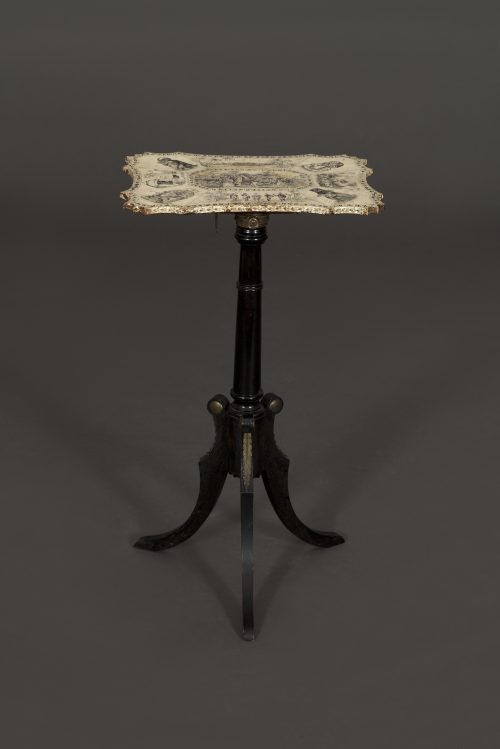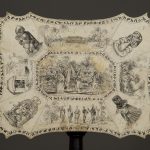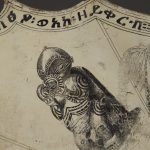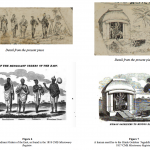11388 A UNIQUE WHITE LACQUER PENWORK CARTOUCHE SHAPED ADJUSTABLE CENTER TABLE CUM FIRESCREEN WITH REMARKABLE FINELY DRAWN DEPICTIONS OF EXOTIC FIGURAL VIGNETTES AFTER ENGRAVINGS FROM THE CHURCH MISSIONARY SOCIETY’S MISSIONARY REGISTER English. Circa 1820. Measurements: Height: 28 1/4″ (71.7 cm) Width: 16″ (40.6 cm) Depth: 12 1/4″ (31 cm) Maximum extended tilted height: 47 3/4″ […]

Research
Of ebonized and white lacquered wood and gilt brass mounts. The cartouche shaped top with central vignette depicting an encampment with European and exotically clad characters. The borders with exotic possibly fictive lettering. The outer boarder with images and vignettes of figures in tribal ceremonial dress and face masks. The adjustable ebonized stand with gun barrel stem and the whole resting on elegant outplayed triform acanthine gilt brass mounted legs.
The Church Missionary Society was founded on 12 April 1799 at an Eclectic Society meeting, with the support of the Evangelical Christian social reformation group, the Clapham Sect. The founders of the group, who included Henry Thornton, Thomas Babington and William Wilberforce, were committed to abolishing slavery, creating social reform, and global evangelization.1 During the CMS’s initial meeting, they resolved “It is a duty highly incumbent upon every Christian to endeavor to propagate the knowledge of the Gospel amongst the Heathen.”2 The CMS overseas missionary work began in 1804 in Sierra Leone, and would quickly spread to regions of New Zealand, India, and Canada. From 1813-55, the society published The Missionary Register, which included firsthand accounts of the native customs and artifacts encountered by the CMS during their missionary trips.
All of the elements decorating this unique white lacquer and penwork center table are taken from different volumes of the Church Missionary Society’s Missionary Register, published between 1816 and 1820.
The general theme is the depiction of native idols and religious practices, with a focus on belief structures which the Society deemed particularly challenging, as well as what the Society regarded as great achievements in the dissemination of Christian ideas.
Interestingly, a script is written around the outer border of the images and is partly repeated on the inner border; it is the classic Ethiopian script known as Ge’ez, and survives today only as a church language. The lines are taken from an Ethiopic manuscript containing the first eight books of the Old Testament, a text which the CMS hoped would help to revive scholarship and interest in the Ancient Church of Abyssinia. Few Ethiopic scriptures had been printed, and the Society established representatives in the Mediterranean with the purpose of opening communication with Abyssinia, which possessed some of the remaining extant holy scriptures in need of transcribing and preservation. The volume acquired by the CMS contained “285 folios, of which the text covers 282, very accurately written, and in high preservation.”3
The text, an extract from the ‘remarkable prophecy’ of Balaam, is reproduced for the first time in the 1817 edition of the CMS Missionary Register (figure 1) including its translation from the ‘Ethiopic’ and reads: I shall see him, but not now: I shall call him blessed, but he is not near: there shall arise a star out of Jacob, and from Israel shall it arise: and he shall destroy the ambassadors of Moab, and shall take captive all the Children of Seth.4 A compilation of 17th century Ethiopic bible selections, a faithful copy of a 15th century original, is held in the British Library and can be compared to the reprinted text of the Register (figure 2)
The central scene of the table top comes from the 1820 edition of the Register, entitled The devil of the Bassas, in Western Africa (figure 3), who is represented by the ‘terrific figure’ clad in a pointed hat and grass garment who the natives are taught to believe is the “Devil… able and ready to inflict on them all kinds of injury…”.5 The people to the right “holding a conference” with this figure are the “late excellent Mr. Cates in his light dress in which he travelled,”6 accompanied by his Christian Native Friends, William Tamba and William Davis. It was agreed with the chief of King John’s Town, near Cape Mesurado, that the latter would remain as a Christian Teacher.
The engraving on the upper middle aspect of the top, above the central scene, depicts the “Native School at Lakoody, Near Burdwan, with part of the village,” published in the CMS Missionary Register of 1819 (figure 4). It represents the great advances missionary efforts made in teaching tens of thousands of Indian boys to read and write, while disseminating Protestant/Christian religious beliefs.
The panel at middle right depicts a man wearing nothing but a fishlike headdress, made of bamboo sticks, net and porcupine quills. It was published in the 1816 Register and is known as ‘Kolloh-man,’ who is said to reside amongst the Bullom people in the West African area of Yongroo (figure 5). The Kolloh is believed to be a powerful Devil spirit who comes out when a local tribe leader dies and riots and looting ensue. The Kolloh threatens people into observing proper mourning rites, but also captures children and instructs them in the mysteries of Kolloh. It was a particular goal of the Mission in that region to “banish not only this representative of the Devil, but the Devil himself from the Bullom Shore. He has great power in this benighted spot.”7
The lower center panel depicts Five of the Mendicant Orders of the East including Dundee, Brumhucharee, Ramatu, Voishnuvu and Mussulman Fakeer, published in 1818 (figure 6). The accompanying text describes the Hindoo belief system underlying the creation of the castes and concludes that “Caste is, in truth, the great bond of Hindoo Superstition, and the upholder among that people of the empire of the enemy of mankind. It presents, in its numberless ramifications and varied influence the most formidable obstacle to the reception of that heavenly doctrine.”8 The different occupations and dress of the mendicant orders are also described.
The middle left hand scene depicts the Hindoo Goddess called ‘Juguddhatree’ (figure 7), from the Missionary Register of 1817. She is represented with four arms, with which she holds a conch, a discus, a club and a water lily flower. Worship of ‘Juguddhatree’ was very popular, and would often include dances, singing and the feasting of Brahmins. Here, large groups of singers and dancers would be hired, and men would stand as guards near the temple.9 In the present scene, the aftermath of a human sacrifice to Juguddhatree is depicted. Close by the temple, and visible in the forefront of the scene, was an instrument used for cutting the head off the scarified animal or human. This action was to be done in no more than one cut. “The Shasters have denounced vengeance on the person who shall fail to cut off the head at one blow: his son will die; or the Goddess of Fortune will Forsake him.”10
The corners of the table top are devoted to indigenous idols. The upper left corner depicts a highly unusual figure supporting an oversized ‘mouth’ with its hands (figure 8). The strange being, with a round head and and blocky appendages, is depicted in an engraving in the 1816 CMS Register. There is some disagreement over the image’s significance to the native people. While some suggest figures such as these are intended to represent a deity, others believe that New Zealanders did not worship any idols. An account in the Register explains: “I have put the question to them, on seeing their images in wood and stone, whether they considered them as the representations of Atua, and they have uniformly denied that they did so; and what tends to confirm me in my opinion, is their readiness in bartering them away.”11
The engraving on the upper right corner of the present top comes from the same issue of 1816 and depicts an image of a protective deity, called Hei Tiki, found throughout New Zealand (figure 9). These figures were often worn by tribal Chiefs and their wives during times of danger. The diety was believed to live in the Moon, which held a special significance to New Zealanders. As described in the 1816 Register, the native people “have a notion that the Moon is the abode of a Man, who, at some distant period, paid a visit to New Zealand, and who is still very anxious for its welfare, and for that of its inhabitants.”12
The extensive chapter on worship of ‘The Juggernaut’, depicted on the bottom right corner of the present table, is taken from earlier publications on Hindoo traditions published by Mr. Ward and Dr. Ryland in the CMS Register of 1817 (figure 10). It describes in detail the rapturous crowds attending this worship where the deity is paraded in a large ‘car’ with numerous believers willingly offering themselves as human sacrifices.
Finally, ‘Ganesa. A Hindoo Deity’ is depicted on the lower left corner of the present table, taken from the engraving of the 1819 edition of the Missionary Register (figure 11). Described as God of Wisdom of Hindoostan and painted with an Elephant’s Head, it is “the symbol of sagacious discernment and attended by a favorite Rat, which the Indians consider as a wise and provident animal.”13 The account proceeds to describe how the Idol is worshipped in different regions and recounts the detailed beliefs and myths associated with this symbol.
As far as is known, no other piece of Regency furniture employs penwork as a medium to depict with great accuracy an actual documentary record that alludes to Christian missionary work and adventures of the early nineteenth century. Its highly specific subject matter gives rise to the view that it was a commissioned item for a wealthy individual within the missionary movement, possibly a relative or friend of Mr. Cates, who is posthumously depicted in the center of the main panel, while conversing with the ‘Devil.’14 Its function as a fire screen meant its owner had occasion to view and enjoy its scenes often.










Comments are closed.